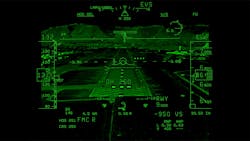Collins to demonstrate C-130J enhanced-vision and image processing for low-visibility aerial fire fighting
WRIGHT-PATTERSON AFB, Ohio – U.S. Air Force cockpit avionics experts needed a digital heads-up display (digital HUD) to demonstrate the ability of the C-130J utility aircraft to fight forest fires and fly in close formation in smoke, bad weather, and at night. They found their solution from Raytheon Collins Aerospace.
Officials of the Air Force Life Cycle Management Center at Wright-Patterson Air Force Base, Ohio, announced a $5.8 million contract last week to the Raytheon Technologies Corp. Collins Aerospace segment in Cedar Rapids, Iowa, to demonstrate the Collins EVS-3600 digital HUD aboard an Air Force C-130J aircraft equipped with the Modular Airborne Fire Fighting System (MAFFS).
These aircraft routinely fly low-visibility missions into smoke-obscured mountainous terrain below 1,000 feet closely behind a lead aircraft to drop fire-retardent chemicals that help extinguish forest fires.
MAFFS aircraft also fly operations after sunset, which makes crews susceptible to visual illusions created by the loss of daylight, combined with reduced visibility conditions due to smoke.
Related: The role of image and video processing
MAFFS units fit inside C-130 airplanes without requiring structural modification, and can be loaded on short notice. It takes about two hours to load a MAFFS unit onto the C-130, which then drops fire retardant from an altitude of about 150 feet.
A MAFFS unit can discharge about 3,000 gallons in less than five seconds to cover an area one-quarter of a mile long and 60 feet wide. Today, one Air Force Reserve Command and three Air National Guard locations participate in the MAFFS program.
The 302nd Airlift Wing in Colorado Springs, Colo., is the only Reserve unit. The Guard units include the 145th AW in Charlotte, N.C.; the 146th AW in Channel Islands, Calif., and the 153rd AW in Cheyenne, Wyo. The 302nd AW has two of the MAFFS units and the Guard has two units each for a total of eight systems nationwide.
An enhanced vision system helps air crews see through fog, smoke, dust, blowing sand, and other obscurants, and can improve aircrew situational awareness and safety significantly in these conditions. The Collins EVS-3600 enhanced vision system will improve MAFFS and mobility mission success rates and increase safety margins, Air Force officials say.
The enhanced vision system not only can augment aerial fire fighting, but it also can help with military operations such as formation flying, low-level situational awareness, obstacle avoidance, and objective area acquisition in particle-obscured environments.
Collins will create software to display an enhanced vision system on a digital HUD aboard the demonstrate C-130J, permanently replace the analog HUD with the improved digital HUD on the test aircraft, and demonstrate the technology on the aircraft during low-visibility weather conditions like fog, smoke, and heavy rain during the fire-fighting season.
Collins avionics experts will demonstrate formation flying at 1,000 and 1,500 feet while following a lead aircraft similar in size to those used by the U.S. Forest Service.
The Collins enhanced vision system software must be able to verify enhanced visibility in fog or smoke during the day, and during recovery to austere tanker bases with limited-approach lighting systems.
Related: Common technologies for manned and unmanned aircraft
The enhanced vision system software will provide primary flight reference information to the copilot as primary flight display. Collins experts also will demonstrate three different kinds of sensors -- visual, short-wave infrared, and long-wave infrared in video format on the digital HUD, and image processing and data fusion for automatic adjustment of gains.
As the designer, developer, and sole manufacturer of the certified and fielded C-130J digital HUD and compatible enhanced vision system, Collins is the only business with enough detailed knowledge of the design to adequately produce and support this demonstration, Air Force officials say.
For more information contact Raytheon Collins Aerospace online at www.rtx.com/who-we-are/our-businesses#ca, or the Air Force Life Cycle Management Center at www.aflcmc.af.mil.
About the Author
John Keller
Editor-in-Chief
John Keller is the Editor-in-Chief, Military & Aerospace Electronics Magazine--provides extensive coverage and analysis of enabling electronics and optoelectronic technologies in military, space and commercial aviation applications. John has been a member of the Military & Aerospace Electronics staff since 1989 and chief editor since 1995.
